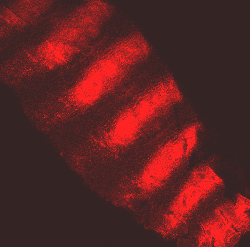Tweedle Coat Fashions Stocky Flies
October 26, 2006
By Sherry Seethaler

Tweedle proteins (Red) in the cuticle of fruit fly larvae
University of California, San Diego biologists have discovered that disruptions in genes they call Tweedles make fruit flies short and stout like Tweedledee and Tweedledum in Alice in Wonderland. They report in this week's issue of the journal Proceedings of the National Academy of Sciences that a defective TweedleD protein in the outer coat of fly larvae makes them appear compressed.
"It's not a trivial matter to put a shell on from the inside," explained Steven Wasserman, a professor of biology who headed the research team. "An insect needs to build up the flexibility, strength and shape of each part before sealing the outside. If you've ever peeled a golf ball, you realize there isn't just one thing holding it all together. Each part contributes."
The researchers discovered 27 different Tweedle genes in fruit flies. The different proteins in the Tweedle family are found in different parts of the cuticle-the tough outer coat in fly embryos and larvae. The exact function of the Tweedles is not known, but the researchers think they strengthen the cuticle. Make one part too weak or too strong and the larvae end up resembling their namesake.

Photo Credit: X. Guan, UCSD
Tweedles may be good targets for novel insecticides, the researchers say, because the gene family appears to be unique to insects. "We've discovered Tweedle genes in all insect species we've examined, but not in any other species," said Xiao Guan, a graduate student working with Wasserman and first author of the study.
Brooke Middlebrooks and Sherry Alexander of UCSD also contributed to the study. The research was supported by the National Institutes of Health.
Media Contact: Sherry Seethaler sseethaler@ucsd.edu (858) 534-4656
Comment: Steven Wasserman stevenw@ucsd.edu (858) 822-2408
